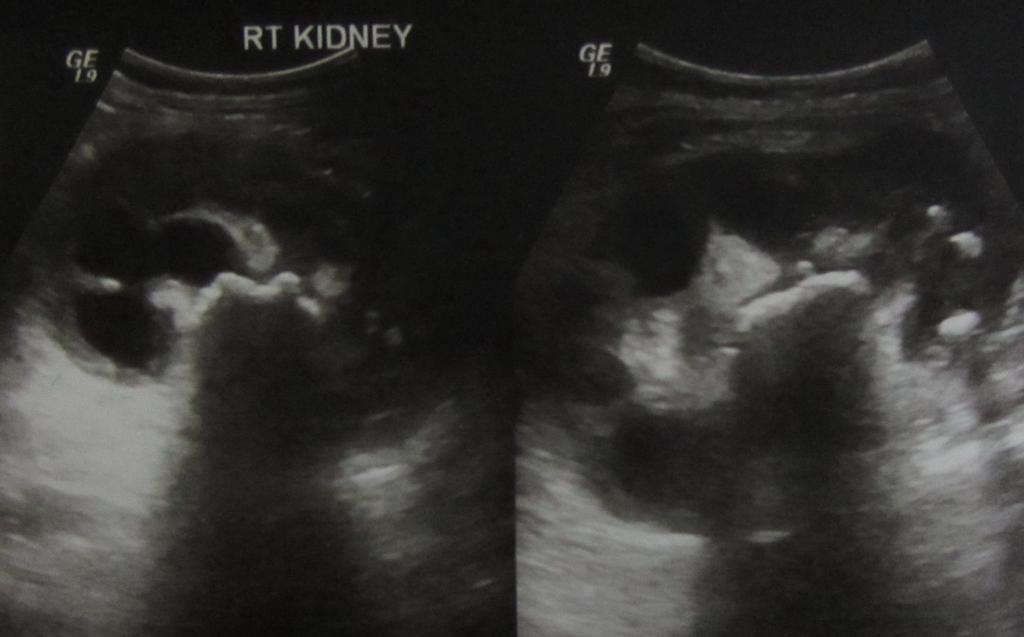Pyelonephritis echocardiography and ultrasound: Difference between revisions
Jump to navigation
Jump to search
Usama Talib (talk | contribs) |
Usama Talib (talk | contribs) |
||
| Line 9: | Line 9: | ||
==Ultrasound== | ==Ultrasound== | ||
The diagnosis of pyelonephritis using ultrasound can have the following important aspects to be noticed | The diagnosis of pyelonephritis using ultrasound can have the following important aspects to be noticed<ref name="https://radiopaedia.org/">Radiopaedia.org. Case courtesy of Dr Ian Bickle, <a href="https://radiopaedia.org/">Radiopaedia.org</a>. From the case <a href="https://radiopaedia.org/cases/20872">rID: 20872</ref> | ||
* In patients with recurrent ascending urinary tract infections, it may be necessary to exclude an anatomical abnormality, such as vesicoureteral reflux (urine from the bladder flowing back into the [[ureter]]) or [[polycystic kidney disease]]. Investigations that are commonly used in this setting are [[medical ultrasonography|ultrasound]] of the kidneys or [[voiding cystourethrogram|voiding cystourethrography]]. | * In patients with recurrent ascending urinary tract infections, it may be necessary to exclude an anatomical abnormality, such as vesicoureteral reflux (urine from the bladder flowing back into the [[ureter]]) or [[polycystic kidney disease]]. Investigations that are commonly used in this setting are [[medical ultrasonography|ultrasound]] of the kidneys or [[voiding cystourethrogram|voiding cystourethrography]]. | ||
Revision as of 16:25, 27 January 2017
|
Pyelonephritis Microchapters |
|
Diagnosis |
|
Treatment |
|
Case Studies |
|
Pyelonephritis echocardiography and ultrasound On the Web |
|
American Roentgen Ray Society Images of Pyelonephritis echocardiography and ultrasound |
|
Risk calculators and risk factors for Pyelonephritis echocardiography and ultrasound |
Editor-In-Chief: C. Michael Gibson, M.S., M.D. [1]
Overview
Ultrasonography is an effective non invasive technique in the diagnosis of pyelonephritis. It is sometime used as a replacement of cortical scintigraphy in the diagnosis of acute pyelonephritis in children.[1][2][3]
Ultrasound
The diagnosis of pyelonephritis using ultrasound can have the following important aspects to be noticed[4]
- In patients with recurrent ascending urinary tract infections, it may be necessary to exclude an anatomical abnormality, such as vesicoureteral reflux (urine from the bladder flowing back into the ureter) or polycystic kidney disease. Investigations that are commonly used in this setting are ultrasound of the kidneys or voiding cystourethrography.
- Emphysematous Pyelonephritis: Ultrasound will characteristically show an enlarged kidney containing high-amplitude echoes within the renal parenchyma, often with low-level posterior dirty acoustic shadowing; however, the depth of parenchymal involvement may be underestimated at ultrasound, and multiple renal stones may also manifest as echogenic foci without "clean" posterior shadowing.
- Xanthogranulomatous Pyelonephritis: At sonography, the inflammatory mass itself is hypoechoic, with central echogenic foci corresponding to renal calculi.
References
- ↑ Fowler JE, Perkins T (1994). "Presentation, diagnosis and treatment of renal abscesses: 1972-1988". J Urol. 151 (4): 847–51. PMID 8126807.
- ↑ Gupta K, Hooton TM, Naber KG, Wullt B, Colgan R, Miller LG; et al. (2011). "International clinical practice guidelines for the treatment of acute uncomplicated cystitis and pyelonephritis in women: A 2010 update by the Infectious Diseases Society of America and the European Society for Microbiology and Infectious Diseases". Clin Infect Dis. 52 (5): e103–20. doi:10.1093/cid/ciq257. PMID 21292654.
- ↑ Kawashima A, LeRoy AJ (2003). "Radiologic evaluation of patients with renal infections". Infect Dis Clin North Am. 17 (2): 433–56. PMID 12848478.
- ↑ Radiopaedia.org. Case courtesy of Dr Ian Bickle, <a href="https://radiopaedia.org/">Radiopaedia.org</a>. From the case <a href="https://radiopaedia.org/cases/20872">rID: 20872
